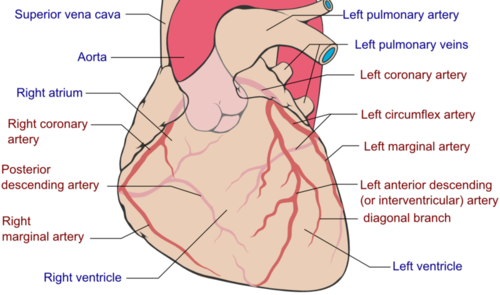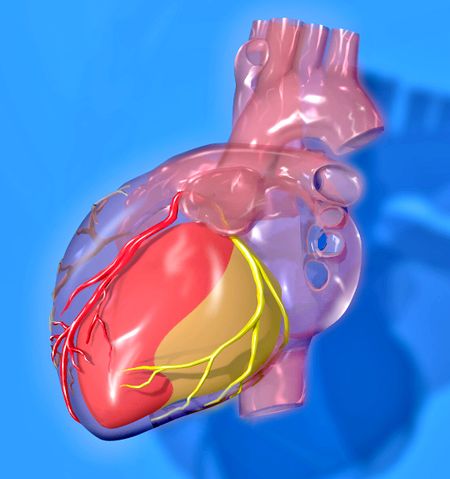Coronary Artery: Difference between revisions
(added original editor) |
No edit summary |
||
| (13 intermediate revisions by 2 users not shown) | |||
| Line 1: | Line 1: | ||
<div class="editorbox"> '''Original Editor '''- [[User:Rania Nasr|Rania Nasr] | <div class="editorbox"> | ||
'''Original Editor '''- [[User:Rania Nasr|Rania Nasr]] | |||
'''Top Contributors''' - {{Special:Contributors/{{FULLPAGENAME}}}} | '''Top Contributors''' - {{Special:Contributors/{{FULLPAGENAME}}}} | ||
</div> | </div> | ||
== | == Introduction == | ||
[[File:Coronary Arteries.png | [[File:Coronary Arteries.png|Coronary Arteries|right|frameless|500x500px]]The coronary [[arteries]] arise from the coronary sinuses immediately distal (superior) to the [[Aortic Valve Disease|aortic]] valve and supply the myocardium with oxygenated [[blood]] | ||
* This is a crucial function for myocardial function and subsequently homeostasis of the body<ref name=":0">Ogobuiro I, Tuma F. [https://www.ncbi.nlm.nih.gov/books/NBK534790/ Anatomy, Thorax, Heart Coronary Arteries.] In: StatPearls [Internet]. Treasure Island (FL): StatPearls Publishing; 2019 Jan.</ref>. | |||
They branch and encircle the [[Anatomy of the Human Heart|heart]] to cover its surface with a lacy network, perhaps resembling a slightly crooked crown.<ref name=":1">Radiopedia [https://radiopaedia.org/articles/coronary-arteries Coronary arteries] Available from:https://radiopaedia.org/articles/coronary-arteries (last accessed 5.8.2020)</ref> | |||
== | == Gross Anatomy == | ||
The coronary arteries | The typical configuration consists of two coronary arteries, arising from the left posterior and right anterior aortic or coronary sinuses respectively, in the proximal ascending aorta. These are the only two branches of the ascending [[aorta]]. | ||
# Left coronary artery (LMCA): The left coronary artery has a short common stem (and is hence often referred to as the left main coronary artery), that bifurcates into the left circumflex artery (LCx), which courses over the left atrioventricular groove, and the left anterior descending artery (LAD), which passes towards the apex in the anterior interventricular groove. | |||
# Right coronary artery (RCA): The right coronary artery courses in the right atrioventricular groove to the inferior surface of the heart, whereupon it turns anteriorly at the crux as the posterior descending artery (PDA) in right dominant circulation. | |||
Occasionally there is a trifurcation (in ~15%), with the third branch, the ramus intermedius, arising inbetween the LAD and LCx. In left dominant hearts, the LCx supplies the posterior descending artery (PDA)<ref name=":1" />. | |||
== | == Coronary Dominance == | ||
* Most [[Anatomy of the Human Heart|hearts]] are right dominant (60%) where the PDA is supplied by the RCA. | |||
* However, up to 20% of hearts may be left dominant, where the PDA is supplied by the LAD or LCx, or codominant, where a single or duplicated PDA is supplied by branches of both the RCA and LAD/LCx (20%).<ref name=":1" /> | |||
== Supply == | == Supply == | ||
The RCA emerges from the anterior ascending aorta and supplies blood to the right atrium, right ventricle, SA node, and AV node. It descends into smaller branches including the right posterior descending artery (PDA) and acute marginal artery | [[File:Heart coronary territories.jpg|right|frameless|479x479px]] | ||
The RCA emerges from the anterior ascending aorta and supplies blood to the right atrium, right ventricle, SA node, and AV node. | |||
* It descends into smaller branches including the right posterior descending artery (PDA) and acute marginal artery. | |||
The LMCA gives off two major branches; the left anterior descending (LAD) and the left circumflex (LCx) coronary arteries, which supply blood to the left atrium and left ventricle. The LAD supplies blood to the front and the left side of the heart. The circumflex artery is responsible for blood supply to the left atrium and the posterior-lateral aspect of the left ventricle<ref name=":0" />. | * In conjunction with the left anterior descending artery (LADA), the RCA helps supply blood to the septum of the heart<ref name=":0" />. | ||
The LMCA gives off two major branches; the left anterior descending (LAD) and the left circumflex (LCx) coronary arteries, which supply blood to the left atrium and left ventricle. | |||
* The LAD supplies blood to the front and the left side of the heart. | |||
* The circumflex artery is responsible for blood supply to the left atrium and the posterior-lateral aspect of the left ventricle<ref name=":0" />. | |||
== Clinical Relevance == | == Clinical Relevance == | ||
Coronary artery disease (CAD, also called coronary heart disease, or CHD) | Like other arteries, the coronaries may be subject to [[Atherosclerosis|arteriosclerosis]] (hardening of the arteries) causing [[Coronary Artery Disease (CAD)|Coronary artery disease]] (CAD, also called coronary heart disease, or CHD). | ||
{{#ev:youtube|3wpT-4bSmoU|300}}<ref>Armando Hasudungan. Cardiology - Coronary Blood Supply. Available from: https://www.youtube.com/watch?v=3wpT-4bSmoU [last accessed 26/9/2019]</ref> | Arteries that have become extremely narrow can cause shortness of breath and [[angina]] during [[Physical Activity|physical activity]]. If a coronary artery suddenly becomes completely blocked, it can result in a [[Myocardial Infarction|Myocardial Infarct]]/heart attack<ref>InformedHealth.org [Internet]. Cologne, Germany: Institute for Quality and Efficiency in Health Care (IQWiG); 2006-. [https://www.ncbi.nlm.nih.gov/books/NBK355313/ Coronary artery disease: Overview.] 2013 Feb 13 [Updated 2017 Jul 27]. </ref>.{{#ev:youtube|3wpT-4bSmoU|300}}<ref>Armando Hasudungan. Cardiology - Coronary Blood Supply. Available from: https://www.youtube.com/watch?v=3wpT-4bSmoU [last accessed 26/9/2019]</ref> | ||
[[Coronary Artery Bypass Graft|Bypass surgery]] - A surgical procedure performed to improve blood supply to the heart by creating new routes for blood flow when one or more of the coronary arteries become obstructed. The surgery involves removing a healthy blood vessel from another part of the body, such as the leg, and grafting it onto the heart to circumvent the blocked artery<ref>Your Dictionary Bypass surgery Available from:https://www.yourdictionary.com/coronary-bypass-surgery (last accessed 5.8.2020)</ref>. Those most often bypassed today include the right coronary artery, the posterior descending coronary artery, the left main coronary artery, the left anterior descending coronary artery and the left circumflex coronary artery. Plaques obstructing the coronary arteries may also be treated by balloon angioplasty, stents, and other techniques<ref>Medicine net CA Available from:https://www.medicinenet.com/script/main/art.asp?articlekey=7250 (last accessed 5.8.2020)</ref>. | |||
== Related pages == | == Related pages == | ||
[[Acute Coronary Syndrome]] | [[Acute Coronary Syndrome]] | ||
| Line 38: | Line 49: | ||
<references /> | <references /> | ||
[[Category:Arteries]] | [[Category:Arteries]] | ||
[[Category:Cardiovascular Disease]] | |||
[[Category:Cardiopulmonary]] | |||
[[Category:Anatomy]] | |||
[[Category:Heart - Anatomy]] | |||
Latest revision as of 12:23, 18 July 2021
Original Editor - Rania Nasr
Top Contributors - Lucinda hampton, Rania Nasr and Kim Jackson
Introduction[edit | edit source]
The coronary arteries arise from the coronary sinuses immediately distal (superior) to the aortic valve and supply the myocardium with oxygenated blood
- This is a crucial function for myocardial function and subsequently homeostasis of the body[1].
They branch and encircle the heart to cover its surface with a lacy network, perhaps resembling a slightly crooked crown.[2]
Gross Anatomy[edit | edit source]
The typical configuration consists of two coronary arteries, arising from the left posterior and right anterior aortic or coronary sinuses respectively, in the proximal ascending aorta. These are the only two branches of the ascending aorta.
- Left coronary artery (LMCA): The left coronary artery has a short common stem (and is hence often referred to as the left main coronary artery), that bifurcates into the left circumflex artery (LCx), which courses over the left atrioventricular groove, and the left anterior descending artery (LAD), which passes towards the apex in the anterior interventricular groove.
- Right coronary artery (RCA): The right coronary artery courses in the right atrioventricular groove to the inferior surface of the heart, whereupon it turns anteriorly at the crux as the posterior descending artery (PDA) in right dominant circulation.
Occasionally there is a trifurcation (in ~15%), with the third branch, the ramus intermedius, arising inbetween the LAD and LCx. In left dominant hearts, the LCx supplies the posterior descending artery (PDA)[2].
Coronary Dominance[edit | edit source]
- Most hearts are right dominant (60%) where the PDA is supplied by the RCA.
- However, up to 20% of hearts may be left dominant, where the PDA is supplied by the LAD or LCx, or codominant, where a single or duplicated PDA is supplied by branches of both the RCA and LAD/LCx (20%).[2]
Supply[edit | edit source]
The RCA emerges from the anterior ascending aorta and supplies blood to the right atrium, right ventricle, SA node, and AV node.
- It descends into smaller branches including the right posterior descending artery (PDA) and acute marginal artery.
- In conjunction with the left anterior descending artery (LADA), the RCA helps supply blood to the septum of the heart[1].
The LMCA gives off two major branches; the left anterior descending (LAD) and the left circumflex (LCx) coronary arteries, which supply blood to the left atrium and left ventricle.
- The LAD supplies blood to the front and the left side of the heart.
- The circumflex artery is responsible for blood supply to the left atrium and the posterior-lateral aspect of the left ventricle[1].
Clinical Relevance[edit | edit source]
Like other arteries, the coronaries may be subject to arteriosclerosis (hardening of the arteries) causing Coronary artery disease (CAD, also called coronary heart disease, or CHD).
Arteries that have become extremely narrow can cause shortness of breath and angina during physical activity. If a coronary artery suddenly becomes completely blocked, it can result in a Myocardial Infarct/heart attack[3].
Bypass surgery - A surgical procedure performed to improve blood supply to the heart by creating new routes for blood flow when one or more of the coronary arteries become obstructed. The surgery involves removing a healthy blood vessel from another part of the body, such as the leg, and grafting it onto the heart to circumvent the blocked artery[5]. Those most often bypassed today include the right coronary artery, the posterior descending coronary artery, the left main coronary artery, the left anterior descending coronary artery and the left circumflex coronary artery. Plaques obstructing the coronary arteries may also be treated by balloon angioplasty, stents, and other techniques[6].
Related pages[edit | edit source]
Physical Activity and Cardiovascular Disease
References[edit | edit source]
- ↑ 1.0 1.1 1.2 Ogobuiro I, Tuma F. Anatomy, Thorax, Heart Coronary Arteries. In: StatPearls [Internet]. Treasure Island (FL): StatPearls Publishing; 2019 Jan.
- ↑ 2.0 2.1 2.2 Radiopedia Coronary arteries Available from:https://radiopaedia.org/articles/coronary-arteries (last accessed 5.8.2020)
- ↑ InformedHealth.org [Internet]. Cologne, Germany: Institute for Quality and Efficiency in Health Care (IQWiG); 2006-. Coronary artery disease: Overview. 2013 Feb 13 [Updated 2017 Jul 27].
- ↑ Armando Hasudungan. Cardiology - Coronary Blood Supply. Available from: https://www.youtube.com/watch?v=3wpT-4bSmoU [last accessed 26/9/2019]
- ↑ Your Dictionary Bypass surgery Available from:https://www.yourdictionary.com/coronary-bypass-surgery (last accessed 5.8.2020)
- ↑ Medicine net CA Available from:https://www.medicinenet.com/script/main/art.asp?articlekey=7250 (last accessed 5.8.2020)








